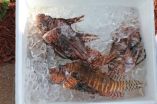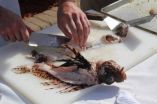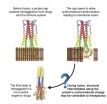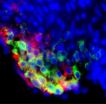(Press-News.org) Scientists have learned that recent fears of invasive lionfish causing fish poisoning may be unfounded. If so, current efforts to control lionfish by fishing derbies and targeted fisheries may remain the best way to control the invasion. And there's a simple way to know for sure whether a lionfish is toxic: test it after it's been cooked.
Pacific lionfish were first reported off the coast of Florida in the 1980s, and have been gaining swiftly in number ever since. They're now found in marine habitats throughout the tropical and subtropical Western Atlantic, Caribbean and Gulf of Mexico, threatening native fishes with their voracious appetites and unchecked population growth. Targeted removal is the only management strategy that seems to help, and many hope to establish a food fishery to increase the fishing pressure on these ravenous predators. Such a strategy is in jeopardy, though, because the FDA added the lionfishes Pterois volitans and Pterois miles to their ciguatera watch list, a catalog of species that may contain the potentially fatal foodborne toxin, citing evidence that lionfish have positively tested for ciguatera. As of July 2014, though, there are no known cases of ciguatera from eating lionfish.
A new study published in Environmental Biology of Fishes may have an explanation for that. Lead author Christie Wilcox of the University of Hawaii thinks there may be a different reason that so many lionfish are coming up positive on ciguatoxin tests: venom proteins might act as ciguatoxin mimics.
"We already know lionfish produce bioactive compounds—just ask anyone who has ever been stung," she said. "We just don't know a whole lot about what those compounds are or whether they occur outside of the venomous spines."
Ciguatera fish poisoning is a foodborne illness caused by eating certain reef fish whose flesh contains ciguatoxins, small lipid toxins originally produced by single-celled dinoflagellates that live on or near the reef. The toxins themselves are colorless, odorless and tasteless, and cannot be destroyed or removed through any normal process of fish preparation, thus accurate testing is the only way to ensure food is safe to consume. Most current test methods are unable to actually detect the toxin compounds, and instead, focus on what the toxins do to cells to determine if a fish is contaminated.
It struck Wilcox that, at the cellular level, lionfish venom might be difficult to distinguish from ciguatoxins because they have similar activities. She took muscle, skin, spine and liver tissue from invasive lionfish and used antibodies against stonefish venom to detect the presence of venom proteins—and found them. "Lionfish express venom-like proteins throughout their bodies," she said. "We don't know exactly what these proteins are or what they're doing, but we know they're there."
Because tissues for ciguatoxin testing undergo preparation in the laboratory to concentrate the toxins, Wilcox further tested whether these proteins made it through common lipid extraction methods used in ciguatoxin testing. Though the amount was reduced, they could still be detected. "These proteins could be making their way into ciguatoxin test dishes," said Wilcox, "and if they are, there's a chance they're messing up our tests."
The presence of these proteins in your fillets is nothing to worry about, though, says Wilcox. "Unlike ciguatoxin, lionfish venom degrades with at room temperature, let alone with heat, so you have nothing to fear from a lionfish dinner."
The negative impact of false positives is the real issue, says co-author Mark Hixon. "Just the fear and rumor of ciguatera is enough to close a fishery, and that's the last thing we need as we try to encourage people to fight lionfish explosion by eating the invader."
Wilcox is quick to note that the work does not prove that lionfish are perfectly safe. "No one is debating that lionfish could be ciguatoxic," says Wilcox. "But there's no reason to think they're any more ciguatoxic that groupers or other smaller predators in an area. If they're popping positive more often than species with the same diet, that indicates there's something fishy going on."
Wilcox hopes that the research will urge researchers to carefully examine their testing protocols to ensure that the proteins she discovered in lionfish tissues don't lead to unwarranted fear of lionfish consumption. "The first, easy step is to cook or boil lionfish samples prior to ciguatoxin testing. Heat degrades the venom proteins, ensuring they don't cause any problems."
INFORMATION:
Christie L. Wilcox and Mark A. Hixon, 2014. False positive tests for ciguatera may derail efforts to control invasive lionfish, Environmental Biology of Fishes, doi: 10.1007/s10641-014-0313-0.
The School of Ocean and Earth Science and Technology at the University of Hawaii at Manoa was established by the Board of Regents of the University of Hawai'i in 1988 in recognition of the need to realign and further strengthen the excellent education and research resources available within the University. SOEST brings together four academic departments, three research institutes, several federal cooperative programs, and support facilities of the highest quality in the nation to meet challenges in the ocean, earth and planetary sciences and technologies.
Invasive lionfish likely safe to eat after all
2014-07-31
ELSE PRESS RELEASES FROM THIS DATE:
Certain Arctic lakes store more greenhouse gases than they release
2014-07-31
New research, supported by the National Science Foundation (NSF), counters a widely-held scientific view that thawing permafrost uniformly accelerates atmospheric warming, indicating instead that certain Arctic lakes store more greenhouse gases than they emit into the atmosphere.
The study, published this week in the journal Nature, focuses on thermokarst lakes, which occur as permafrost thaws and creates surface depressions that fill with melted fresh water, converting what was previously frozen land into lakes.
The research suggests that Arctic thermokarst lakes ...
NASA's Fermi space telescope reveals new source of gamma rays
2014-07-31
Observations by NASA's Fermi Gamma-ray Space Telescope of several stellar eruptions, called novae, firmly establish these relatively common outbursts almost always produce gamma rays, the most energetic form of light.
"There's a saying that one is a fluke, two is a coincidence, and three is a class, and we're now at four novae and counting with Fermi," said Teddy Cheung, an astrophysicist at the Naval Research Laboratory in Washington, and the lead author of a paper reporting the findings in the Aug. 1 edition of the journal Science.
A nova is a sudden, short-lived brightening ...
Study finds physical link to strange electronic behavior
2014-07-31
HOUSTON -- (July 31, 2014) -- Scientists have new clues this week about one of the baffling electronic properties of the iron-based high-temperature superconductor barium iron nickel arsenide. A Rice University-led team of U.S., German and Chinese physicists has published the first evidence, based on sophisticated neutron measurements, of a link between magnetic properties and the material's tendency, at sufficiently low temperatures, to become a better conductor of electricity in some directions than in others.
The odd behavior, which has been documented in a number ...
Hubble shows farthest lensing galaxy yields clues to early universe
2014-07-31
Astronomers using NASA's Hubble Space Telescope have unexpectedly discovered the most distant galaxy that acts as a cosmic magnifying glass. Seen here as it looked 9.6 billion years ago, this monster elliptical galaxy breaks the previous record-holder by 200 million years.
These "lensing" galaxies are so massive that their gravity bends, magnifies, and distorts light from objects behind it, a phenomenon called gravitational lensing. Finding one in such a small area of the sky is so rare that you would normally have to survey a region hundreds of times larger to find just ...
Researchers uncover clues to flu's mechanisms
2014-07-31
HOUSTON – (July 31, 2014) – A flu virus acts like a Trojan horse as it attacks and infects host cells. Scientists at Rice University and Baylor College of Medicine have acquired a clearer view of the well-hidden mechanism involved.
Their computer simulations may lead to new strategies to stop influenza, perhaps even a one-size-fits-all vaccine.
The discovery detailed this week in the Proceedings of the National Academy of Science shows the path taken by hemagglutinin, a glycoprotein that rides the surface of the influenza virus, as it releases fusion peptides to invade ...
UF study advances 'DNA revolution,' tells butterflies' evolutionary history
2014-07-31
GAINESVILLE, Fla. --- By tracing nearly 3,000 genes to the earliest common ancestor of butterflies and moths, University of Florida scientists have created an extensive "Tree of Lepidoptera" in the first study to use large-scale, next-generation DNA sequencing.
Among the study's more surprising findings: Butterflies are more closely related to small moths than to large ones, which completely changes scientists' understanding of how butterflies evolved. The study also found that some insects once classified as moths are actually butterflies, increasing the number of butterfly ...
NYU CDUHR researchers look at prescription opioid abuse among young adults in NYC
2014-07-31
The prevalence of heroin use has been rising steadily in the U.S in recent years. According to the National Survey on Drug Use and Health, the number of individuals reporting past year heroin use almost doubled between 2007 (373,000) and 2012 (669,000). Emerging evidence suggests the increase may be linked to prescription opioid (PO) users who transition from oral and/or intranasal PO use to heroin use, with POs providing the entryway to regular opioid use, and ultimately, heroin injection. This drug-use trajectory appears to have become increasingly common over the past ...
NYU research looks to combat US Latina immigrant obesity
2014-07-31
According to the U.S. Census Bureau, Latinos are the largest minority group in the United States, comprising 16.7% of the population. Approximately one-third of Latinos are obese and are 1.2 times as likely to be obese compared to non-Hispanic Whites.
NYU College of Nursing student researcher Lauren Gerchow, BSN, RN, MSN candidate, has sought to identify the factors that contribute to this problem by compiling a systematic review of qualitative studies that focused on food patterns in Latina women recently published in Nursing Research.
"The review focuses on women ...
Stanford professor finds that wildfires and other burns play bigger role in climate change
2014-07-31
It has long been known that biomass burning – burning forests to create agricultural lands, burning savannah as a ritual , slash-and-burn agriculture and wildfires – figures into both climate change and public health.
But until the release of a new study by Stanford University Civil and Environmental Engineering Professor Mark Z. Jacobson, the degree of that contribution had never been comprehensively quantified.
Jacobson's research, detailed in a paper published July 30 in the Journal of Geophysical Research: Atmospheres, is based on a three-dimensional computer model ...
Childhood coxsackie virus infection depletes cardiac stem cells and might compromise heart health in adults
2014-07-31
There is epidemiological evidence that links type B coxsackie virus (CVB) infection with heart disease, and research published on July 31st in PLOS Pathogens now suggests a mechanism by which early infection impairs the heart's ability to tolerate stress at later stages of life.
CVB infection is very common and affects mostly children. The symptoms range widely: over half of the infections are thought to be asymptomatic, the majority of children who get sick have only a mild fever, and a very small proportion get inflammation of the heart or brain. On the other hand, ...









